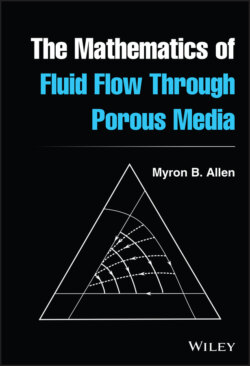Читать книгу The Mathematics of Fluid Flow Through Porous Media - Myron B. Allen III - Страница 28
2.4.2 The Stokes Problem
ОглавлениеAnother classic problem derived from the Navier–Stokes equation examines the slow, incompressible, viscous flow of a fluid around a solid sphere of radius , as drawn in Figure 2.9. In the case of steady flow when the Reynolds number is much smaller than 1, we neglect the inertial terms, arriving at the following mass and momentum balance equations:
On the surface of the solid sphere, the velocity vanishes, while as one moves far away from the sphere the velocity approaches a uniform far‐field value:
In 1851, in a tour de force of vector calculus, Stokes [139] published the solution to this boundary‐value problem, along with an expression for the total viscous force exerted on the sphere: . This force is called the Stokes drag.
For our purposes, we need not examine the calculation of in detail. Instead, we use a simpler dimensional analysis, exploiting concepts from elementary linear algebra, to deduce the functional form of the drag force. Since the only parameters in the boundary‐value problem are , , and , any solution to the problem of calculating defines a relationship of the form
(2.22)
for some function . By a theorem widely attributed to American physicist Edgar Buckingham [31], this relationship, involving variables that have physical dimensions, implies the existence of an equivalent relationship
involving only dimensionless variables Appendix C reviews this theorem.
Thus, we seek relationship equivalent to Eq. (2.22), involving only dimensionless variables formed using powers of the dimensional variables . For any such variable, denoted generically by ,
(2.23)
for exponents to be determined. Equation (2.23) implies that the exponents of , , and must vanish, yielding the following homogeneous linear system for , , , and :
(2.24)
Exercise 2.13 Row‐reduce Eq. (2.24) to deduce that is a free variable, for which one may choose any value, and .
Arbitrarily picking yields the single dimensionless variable ; all other dimensionless variables for this problem must be multiples of this product.
The calculation in Exercise 2.13 shows that any relationship equivalent to Eq. (2.22) but involving only dimensionless variables has the form . Solutions to such an equation are constant values of . Setting for a generic constant , we conclude that Stokes drag has the form
(2.25)
This result is consistent with that of Stokes's original calculation, except that we have an undetermined constant instead of .
To anticipate the constitutive theory of flows in porous media, discussed in Chapter 3, observe that the drag on the solid particle in Eq. (2.25) is proportional to the fluid velocity and the fluid viscosity, and it involves a geometric factor . This result suffices for the derivation pursued in Section 3.1.
